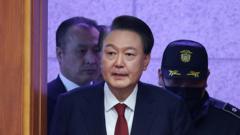South Korea has emerged as a cultural powerhouse, transforming from a niche market in entertainment to a global sensation. With vibrant K-dramas and K-pop artists like Blackpink captivating audiences worldwide, South Korean media reflects both local culture and universal themes, creating a significant fanbase and industry worth billions.
South Korea's Cultural Surge: From K-Dramas to K-Pop

South Korea's Cultural Surge: From K-Dramas to K-Pop
How South Korea transformed into a global cultural phenomenon, impacting fans worldwide through entertainment.
In an age where cultural exchange thrives, South Korea stands out as a formidable force, captivating audiences worldwide with its extraordinary entertainment offerings. Once a side note in the global media landscape, South Korea's entertainment industry has transformed into a multi-billion-dollar powerhouse identified by the likes of K-pop phenomenons like Blackpink and cinematic masterpieces like "Squid Game."
For many fans, like Evan Barringer, a Memphis native turned English teacher in South Korea, this journey of fascination began with a chance encounter with the iconic K-drama "Full House.” A mere 14 years old, Evan unknowingly embarked on a pathway that would lead him to not only explore Korean culture through food and music but also, ultimately, to live and teach in the very country that inspired him. He reflects on the prominence and appeal of K-dramas, stating, “I’ve gotten to see several K-pop artists in concerts whose lyrics I used to study Korean.”
The Korean Wave, or Hallyu as it is often referred, surged to prominence primarily due to the convergence of high-quality production values and burgeoning streaming platforms. Psy’s "Gangnam Style" may have been the initial spark, but the cultural explosion we see today can be attributed to the global accessibility provided by streaming platforms, which have introduced viewers not only to K-pop, but a plethora of genres including romantic dramas and insightful societal commentaries.
A shift in the cultural production landscape occurred post-1987, following the end of military dictatorship in South Korea. As censorship loosened, talented creators began to emerge, drawing inspiration from global cinematic experiences. Investment from chaebols, or conglomerates, funded films and dramas, contributing to an industry that now boasts billions in export income. Social themes in Korean entertainment, including wealth disparity and youthful romance, have captivated audiences around the globe, echoing sentiments of disillusionment found within societies today.
International fans showcase their enthusiasm by immersing themselves in local cuisine and culture, often seeking out dishes they've seen in K-dramas—like spicy kimchi jjigae and comforting kalguksu. For aspiring French actor Mary Gedda, her journey from K-pop aficionado to current resident in Seoul was amplified by her desire to absorb Korean life, leading her to star in minor roles in K-dramas.
This cultural exchange, however, is more than just about romance and relatable experiences. It reflects a longing for an idealized version of life—often characterized by kind heroes and less hypersexualized representations of relationships. Fans like Marie Namur, who moved from Belgium to South Korea, discovered deeper narratives that resonate with universal desires for connection and romance.
While the global appeal continues to flourish, the industry is not without its challenges. With increased scrutiny on the pressures faced by idols and the need for better treatment of creators, there are calls for reform and recognition in an industry that's often characterized by its high standards and expectations.
As South Korea continues to navigate the complexities and triumphs of this cultural ascension, one thing is clear: the world is watching—and captivated.




















